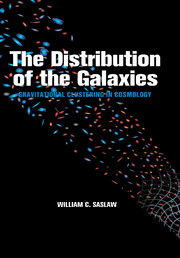Book contents
- Frontmatter
- Contents
- Prologue
- Part I Historical
- Part II Descriptions of Clustering
- 8 Patterns and Illusions
- 9 Percolation
- 10 Minimal Spanning Trees
- 11 Topology
- 12 Fractals
- 13 Bound Clusters
- 14 Correlation Functions
- 15 Distribution Functions
- Part III Gravity and Correlation Functions
- Part IV Gravity and Distribution Functions
- Part V Computer Experiments for Distribution Functions
- Part VI Observations of Distribution Functions
- Part VII Future Unfoldings
- Bibliography
- Index
9 - Percolation
Published online by Cambridge University Press: 19 January 2010
- Frontmatter
- Contents
- Prologue
- Part I Historical
- Part II Descriptions of Clustering
- 8 Patterns and Illusions
- 9 Percolation
- 10 Minimal Spanning Trees
- 11 Topology
- 12 Fractals
- 13 Bound Clusters
- 14 Correlation Functions
- 15 Distribution Functions
- Part III Gravity and Correlation Functions
- Part IV Gravity and Distribution Functions
- Part V Computer Experiments for Distribution Functions
- Part VI Observations of Distribution Functions
- Part VII Future Unfoldings
- Bibliography
- Index
Summary
And pictures in our eyes to get
was all our propagation.
DonnePercolation describes the shape and connectivity of clustering in a quantitative way. It is related to topological and fractal patterns of a distribution. Although these descriptions have not yet been derived from fundamental dynamical theories, they are useful for characterizing the evolution of N-body experiments and for discriminating between different distributions. They are also related to basic properties of phase transitions.
Among the many applications of percolation descriptions are the spread of forest fires, the flow of liquids (particularly oil) through cracks and pores, the shapes and linkage of polymer molecules, atomic spin networks and magnetic domains, and galaxy clustering. Most of these applications occur on a lattice where the distance between interacting neighbors is fixed. Lattice models simplify the analysis greatly, while often retaining some of the essential properties of the system. Of course galaxies are not confined to a lattice, and so we will need a more general approach. However, a simple lattice defines the basic ideas and can be linked to a more continuous distribution.
Starting in one dimension, imagine a straight line divided into segments of equal length and suppose that a galaxy can be found in any segment with probability p. In the simplest case p depends neither on position along the line nor on the presence of neighboring galaxies.
- Type
- Chapter
- Information
- The Distribution of the GalaxiesGravitational Clustering in Cosmology, pp. 69 - 79Publisher: Cambridge University PressPrint publication year: 1999



